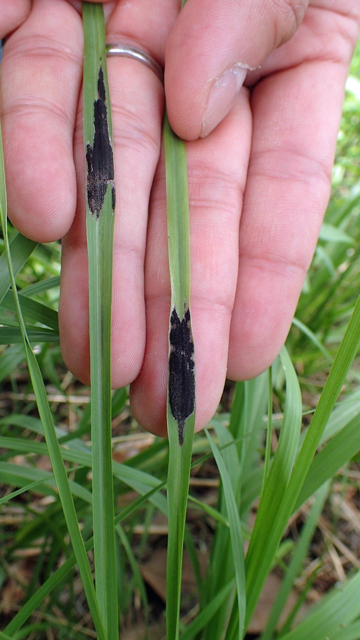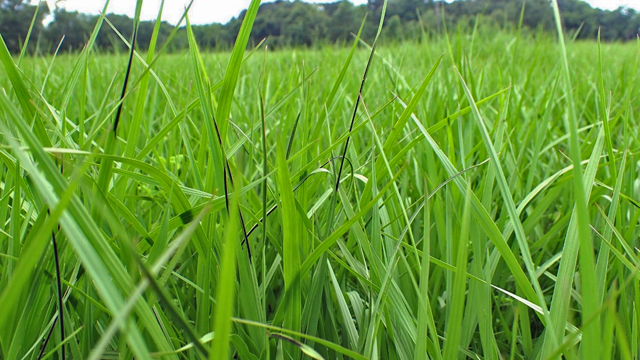
Stroma stage of Myriogenospora atramentosa on Argentine bahiagrass pasture in North Florida. Photo credit: Ko-Hsuan Chen, UF/IFAS
Ann Blount, Sunny Liao, Ko-Hsuan Chen, Marcello Wallau, Doug Mayo, Brittney Justesen and Clay Cooper
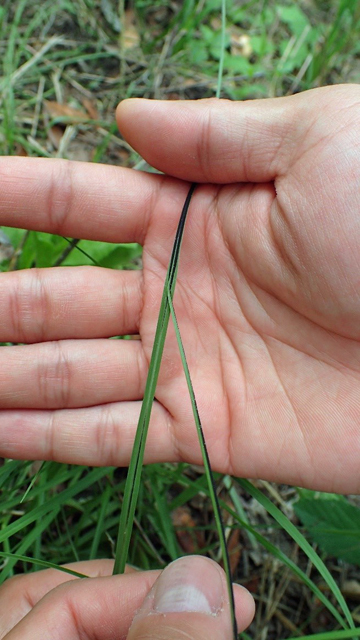
Stroma stage of Myriogenospora atramentosa on Pensacola bahiagrass leaf blade. Photo credit: Ko-Hsuan Chen, UF/IFAS
Endophytes are naturally occurring organisms that often live in symbiosis internally in many of our forage species. Basically, endophytes are good for plants to associate with. They are typically a bacteria or fungus that lives within a plant for all or part of its life-cycle. These organisms occur in most plant species and can boost the plant’s tolerance to abiotic stresses, such as drought, and assist the plant to acquire nutrients, enhance growth, and resist insects and diseases that might harm the plant. They can also aid the plant by reducing overgrazing by wildlife or livestock. In return for aiding the host plant with survival, the endophyte receives nutrients from the host plant, such as carbon or nitrogen.
Recently, these endophytes have been suspected as a possible cause of animal health issues on Florida cattle ranches. This, however, is not a new phenomenon. The most commonly known pasture endophyte relationship occurs in fescue. Cattlemen who rely on fescue-based pastures know what the mycotoxin (ergovaline) from the endophyte fungus Neotyphodium coenophialum in fescue does to cattle. There is a long history of studies to reduce the associated problems of fescue-related mycotoxin toxicity in livestock with better pasture management and fescue variety breeding.
Similar to this phenomena in fescue, endophytic fungi also infect sub-tropical grasses, and in some cases, these endophytes may also produce mycotoxins. Researchers have documented mycotoxin issues in southern grass pastures, but they have not typically been so apparent or serious as fescue toxicosis.
Why the sudden interest in this topic now? Probably because producers have become better livestock stewards and have the annual performance records that document small changes in animal behavior and variation in performance from year to year.
If you research old publications, you will find a number of studies that document the occurrence of these endophytes in many sub-tropical grasses. Old published research articles, dating back to the 1950s and again in the early 1980s, implicate animal health concerns with livestock grazing bermudagrass, bahiagrass, smutgrass and broomsedge.
Over the past three years, several ranchers in Florida have reported livestock problems related to early abortion in cattle, poor bull performance, and heat stress, and have implicated the forages. These performance issues may have been due to a wide range of other factors. Isolating the forages as the cause is hard to confirm. Therefore, a research grant was secured from the Florida Cattlemen’s Association to allow UF/IFAS researchers to do a two-year, statewide study in 13 locations.
A team of 12 University of Florida state specialists and 12 county agents have teamed up with the 13 Florida cattle ranches to do on-farm sampling of Bermudagrass, bahiagrass, and limpograss to determine the level of endophyte toxicity in the state. Four of the 13 locations are in North Florida. Forage samples will be collected six times per year in 2018 and 2019. The goal of this statewide study is to identify the endophytes that are present at different points in the year, so that future studies can focus on how these specific endophytes affect animal performance.
So far, the research team has confirmed the identification of several fungal families living endophytically in pasture grasses, such as Fusarium spp., Balansia spp. and Myriogenospora spp. They have also found seasonal mycotoxin activity in these forages. From recently processed forage samples researchers have identified and quantified the presence of zearalenone, ZEAR-4-sulfate Q1, alternariol, ergine and 15-AcetylDON, as well as several other mycotoxins of potential concern to animal health.
It is still much too early to know if the mycotoxin concentrations from these initial forage plant samples are impacting cattle health or performance. Once this study is complete, future research will focus on the specific endophytes of concern to identify potential management options to recommend to cattle producers in the region.
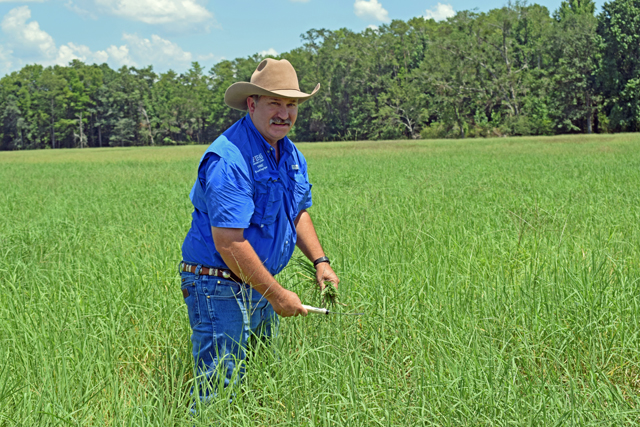
Doug Mayo, Jackson County Extension sampling Tifton 85 Bermudagrass in July 2018 in Jackson County. Photo credit: Ann Blount, UF/IFAS
The UF/IFAS Forage Endophyte team will provide updates as they identify specific endophytes and mycotoxins in Florida forages. They will also be studying their seasonal occurrence and what environmental conditions are favorable for production of mycotoxins.
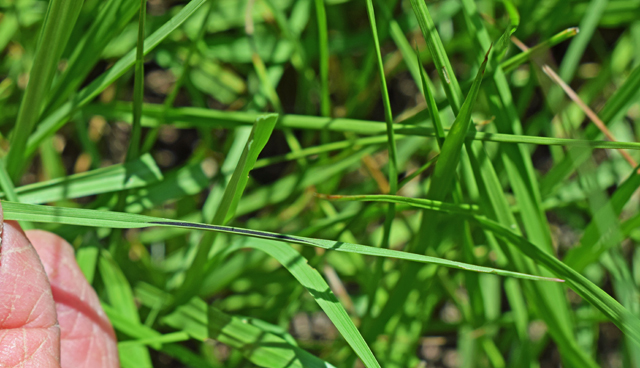
Stroma stage of Myriogenospora atramentosa on Argentine bahiagrass pasture in Jackson County. Photo credit: Doug Mayo
- Cool-Season Forages – A Pasture Perspective for 2022 - September 16, 2022
- Ornamental Rhizoma Perennial Peanut for Groundcover or Alternative Turf - March 18, 2022
- 2021 Cool-Season Forage Recommendations for Livestock and Wildlife - September 24, 2021

